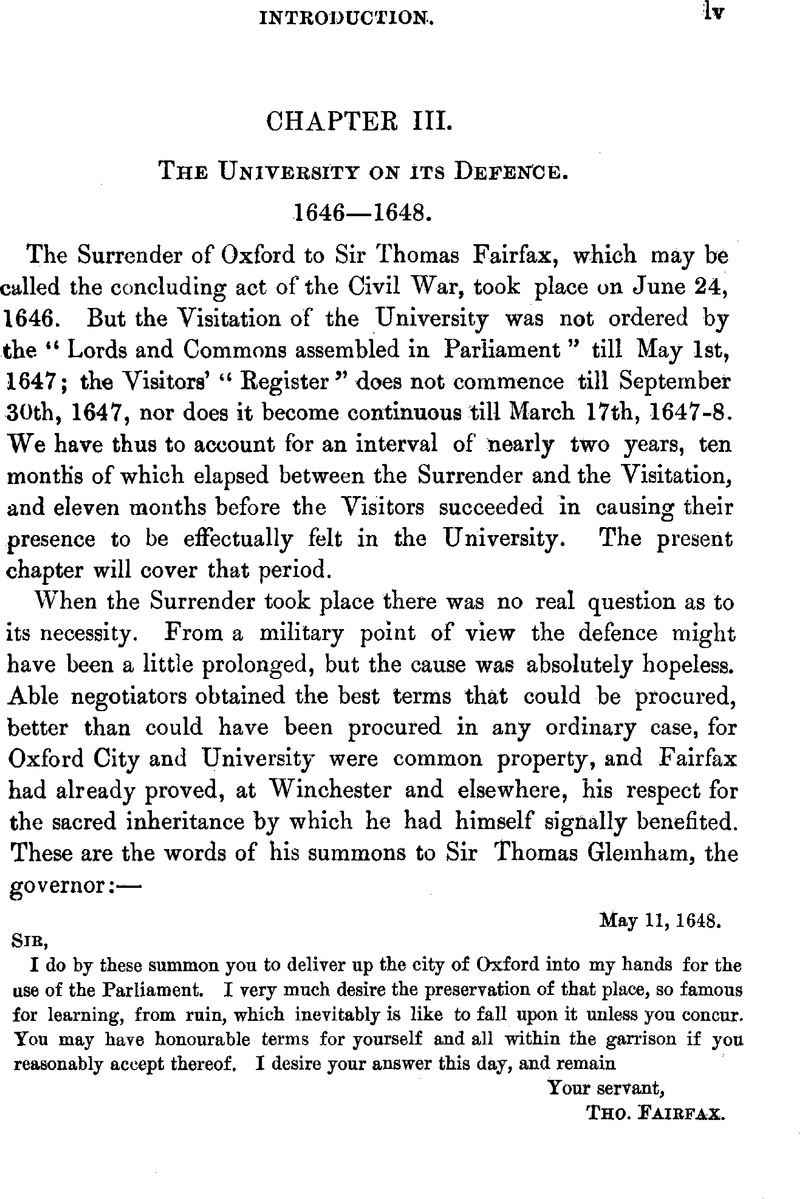No CrossRef data available.
Article contents
Chapter III. The University on its Defence. 1646–1648
Published online by Cambridge University Press: 04 January 2010
Abstract

- Type
- Introduction
- Information
- Camden New Series , Volume 29: The Register of the Visitors of The University of Oxford from A.D. 1647 to A.D. 1658 , December 1881 , pp. lv - lxxvii
- Copyright
- Copyright © Royal Historical Society 1881
References
page lviii a note Some Colleges did not even recover for very many years after the Restoration. Warton, who wrote in 1761, giving an anecdote of the old age and dotage of Dr. Bathurst, President of Trinity, speaks thus of Balliol:—“Balliol College had suffered so much in the outrages of the Grand Rebellion that it remained almost in a state of desolation for some years after the Restoration—a circumstance not to be suspected from its flourishing condition ever since. Dr. Bathurst, who had restored his own College from the ruinous state in which it had been left, was, perhaps, secretly pleased to see a neighbouring, and once a rival, Society reduced to this condition, while his own flourished above all others.” The old man was found (it must have been towards the end of the seventeenth century) one afternoon in his garden, throwing stones at the windows of Balliol, “as if happy to complete its ruin.” (Life of Bathurst, p. 203.)Google Scholar
page lix note a Bloxam's Register of Magdalen College; Sir L. Jenkins's Life of Dr. Mansell. On the other hand, see Ath. Ox. vol. iv. p. 226, for a notice of Samuel Parker constantly “receiving the Sacrament at a Presbyterian meeting-house.”
page lxi note a Reg. Conv. T., April 12th, 1648. Laud's Works, vol. v. part i. p. 205Google Scholar; and Hist. of Troubles and Trial, chap. xxxiii.
page lxiii note a He was the son of Sir Anthony Rous, had been a Commoner of Broadgates Hall, and at his death, in 1658–9 (Jan. 7), left a benefaction to his old Hall, then Pembroke College.
page lxiv note a Wood's Annals; Jacobson's Sanderson's Works, Pref. p. xvii. and authorities there quoted.
page lxviii note a Works, vol. v. part i. p. 224.Google Scholar
page lxviii note b The sense of the difficulty caused by the absence of a Vice-Chancellor is equally felt on both sides. Among the Wood MSS. (F. 35) is an interesting letter from Barlow, of Queen's, of about this date, to Sheldon “at the Court,” bewailing the state of the University in being left ἀκέφαλοι in consequence of Dr. Fell “being ravished from us by a pursuivant,” and consulting Sheldon in the most deferential, not to say obsequious, manner as to whether Dr. Potter, the Pro-Vice-Chancellor, should summon a Convocation, so as to combine and commit the whole University to a definite method of resistance. Sheldon, in concert with Selden, evidently managed the whole of the proceedings which have just been described.
page lxx note a The following extract from the answer of Oriel College, under the signature of Robert Say, the Dean, in the absence of the Provost, to an Order of the Visitors requiring them to send in their books and accounts, may serve as a specimen of the replies given,:—.
“Wee doe humbly conceive that we cannot give that satisfaction unto the particulars in the said summons (as otherwise wee desire to doe) without unavoydable violation of our oaths, which (besides the violence would bee thereby done unto our own consciences) doth at the same instant, according ta our said Statutes, utterly divest us of any right unto or benefit from the said Colledge, which is the principall maintenance of every one of us, of which (being so much concerned therein) we cannot suffer ourselves to make a legall forfeiture.”—Archives of Oriel College. Supplied by the kindness of C. L. Shadwell, Esq. M. A. B.C.L.
page lxx note b His letter to Sheldon describing the scene is in Wood's. MSS. (f 35.)
page lxxi note a Twells, ' Life of Poeock, edit. 1819, vol. i, p. 110.Google Scholar
page lxxi note b The first of the family who occupied the Vyne, near Basingstbke, in succession to the family of Lord Sandysa
page lxxiv note a Keble's Christian Year: Restoration. Charles the First thought Hammond “the most natural orator he had ever heard.”
page lxxiv note b Life, by Matthew Henry, 1699; Wordsworth's Ecclesiastical Biography, vol. vi. p. 142.Google Scholar
page lxxv note a See Boase, 's Reg. Exon. Preface, p. xxvi.Google Scholar
page lxxv note b Ibid, passim.
page lxxv note c Life, pp. 9 and 11.Google Scholar
page lxxv note d Life of Bull, Works, vol. vii. p. 11.Google Scholar
page lxxvi note a See note to p. 130, and Bull's Works, as above.
page lxxvi note b Wynne, 's Life of Sir L. Jenkins, p. 2.Google Scholar
page lxxvii note a Jenkins, 's Life of Mansell, as above, p. 14.Google Scholar


